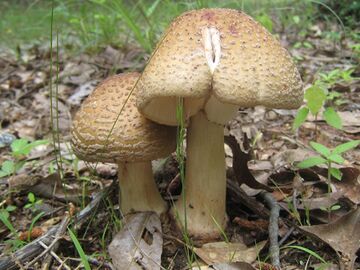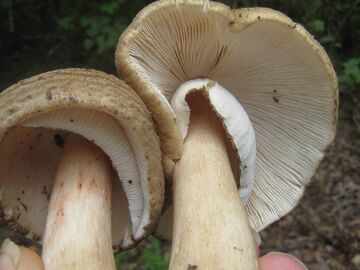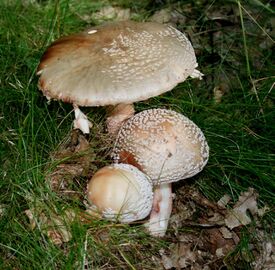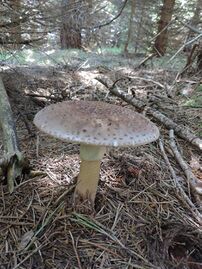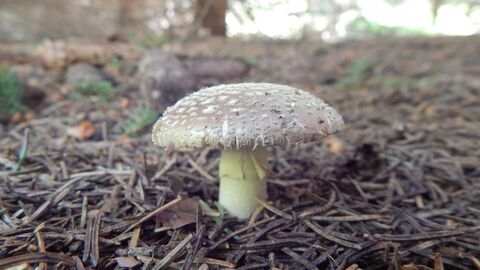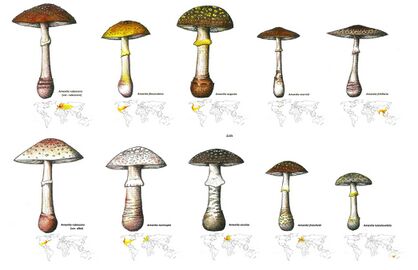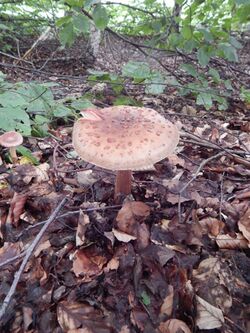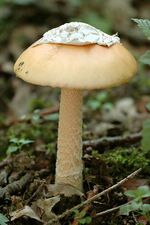Biology:Blusher
| Blusher | |
|---|---|
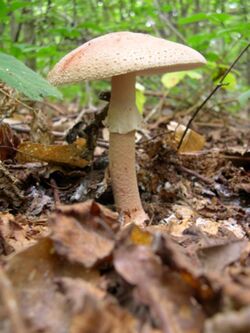
| |
| Amanita rubescens near Piacenza, Italy | |
| Scientific classification | |
| Domain: | Eukaryota |
| Kingdom: | Fungi |
| Division: | Basidiomycota |
| Class: | Agaricomycetes |
| Order: | Agaricales |
| Family: | Amanitaceae |
| Genus: | Amanita |
| Species: | A. rubescens
|
| Binomial name | |
| Amanita rubescens (Pers. ex Fr.) Gray
| |
| Amanita rubescens | |
|---|---|
| Mycological characteristics | |
| gills on hymenium | |
| cap is flat | |
| hymenium is free | |
| stipe has a ring | |
| spore print is white | |
| ecology is mycorrhizal | |
| edibility: edible but not recommended | |
The blusher is the common name for several closely related species of the genus Amanita. A. rubescens, or the blushing amanita,[1] is found in Europe and eastern North America, and A. novinupta, also known as the new bride blushing amanita,[1] is found in western North America. Both their scientific and common names are derived from the propensity of their flesh to turn pink upon bruising or cutting.
The mushroom is edible and tasty, sought for in several European countries. It may however easily be confused with the potentially deadly panther cap by inexperienced foragers, and guides advise extreme caution when collecting this species. Blushers can be distinguished from similar species by the pink or reddish colouration that appears when the mushroom is damaged, typically most visible at the base of the stipe from insect damage.
Description
The European blusher has a reddish-brown convex pileus (cap), that is 5–15 centimetres (2–6 inches) across, and strewn with small white-to-mahogany warts.[2] It is sometimes covered with an ochre-yellow flush which can be washed by the rain. The flesh of the mushroom is white, becoming pink when bruised or exposed to air. This is a key feature in differentiating it from the poisonous false blusher or panther cap (Amanita pantherina), whose flesh does not. The stipe (stem) is white with flushes of the cap colour, and grows to 5–15 cm.[2] The gills are white and free of the stem, and display red spots when damaged. The ring is striate (i.e. has ridges) on its upper side, another feature distinguishing it from A. pantherina. The spores are white, ovate, amyloid,[2] and approximately 8 by 5 µm in size.
The flavour of the uncooked flesh is mild, but has a faint acrid aftertaste. The smell is not strong.
Taxonomy
The true species may be native to Europe, with related species being confused for it in other regions. Western North America's A. novinupta has a whitish cap and blushes pink.[3]
Other closely related species include Amanita brunneolocularis, A. orsonii, A. rubescens var. alba, and A. rubescens var. congolensis.[4]
Distribution and habitat
It is common throughout much of Europe and eastern North America. (In the latter region there are at least three different species that fit into the name A. amerirubescens) It grows on poor soils as well as in deciduous and coniferous woodlands, appearing from June through to November in the UK. It has also been recorded from South Africa, where it is thought to have been accidentally introduced with trees imported from Europe.[5] It has also been recorded from Asia.[6]
In eastern North America, A. rubescens is frequently parasitized by Hypomyces hyalinus. Parasitized fruiting bodies are extremely difficult to recognize unless they occur in conjunction with healthy ones, although some retain the "blushing" characteristic of the species.[7]
Ecology
The mushroom is often attacked by insects.[citation needed]
Uses
A. rubescens is edible when cooked.[8] A. rubescens contains a toxic hemolytic protein in its raw state, although it is not apparently harmful to consume and can be destroyed by cooking.[3]
See also
References
- ↑ 1.0 1.1 "Standardized Common Names for Wild Species in Canada". 2020. https://www.wildspecies.ca.
- ↑ 2.0 2.1 2.2 Davis, R. Michael; Sommer, Robert; Menge, John A. (2012). Field Guide to Mushrooms of Western North America. Berkeley: University of California Press. pp. 73–74. ISBN 978-0-520-95360-4. OCLC 797915861. https://www.worldcat.org/oclc/797915861.
- ↑ 3.0 3.1 Roberts, Peter; Evans, Shelley. The Book of Fungi. University of Chicago Press. pp. 57. ISBN 0-226-72117-5.
- ↑ "Amanita brunneolocularis Tulloss, Ovrebo and Halling". http://pluto.njcc.com/~ret/amanita/species/brunlocu.html.
- ↑ Reid DA, Eicker A (1991). "South African fungi: the genus Amanita". Mycological Research 95: 80–95. doi:10.1016/S0953-7562(09)81364-6. http://www.msu.edu/user/hallenhe/SAJB%20amatoxin.pdf. Retrieved 2007-11-13.
- ↑ Asef M.R. (2020). Field guide of Mushrooms of Iran. Tehran: Iran-Shanasi Press. p. 360. ISBN 9786008351429.
- ↑ Michael Kuo, Hypomyces hyalinus, MushroomExpert.com, Oct. 2003.
- ↑ Phillips, Roger (2010). Mushrooms and Other Fungi of North America. Buffalo, NY: Firefly Books. p. 28. ISBN 978-1-55407-651-2. https://archive.org/details/mushroomsotherfu0000phil.
External links
| Wikimedia Commons has media related to Blusher. |
- "Tabular and Nontabular Keys to the Rubescent Species of Amanita section Validae" by Rodham E. Tulloss, March 10, 2003.
Amanita rubescens
- "Amanita rubescens" by Michael Kuo, MushroomExpert.Com, March 2003.
- "Amanita rubescens Pers.:Fr." by Rodham E. Tulloss, June 25, 2006.
Amanita novinupta
- "Amanita novinupta" by Michael Kuo, MushroomExpert.Com, March 2003.
- "Amanita novinupta Tulloss & J. Lindgr." by Rodham E. Tulloss, July 25, 2006.
- "Amanita novinupta" by Michael Wood & Fred Stevens, MykoWeb, 2004. And will
Other species
- "Amanita brunneolocularis Tulloss, Ovrebo & Halling" by Rodham E. Tulloss, October 6, 2006.
- "Amanita flavorubens (Berk. & Mont.) Sacc." by Rodham E. Tulloss, July 25, 2006.
- "Amanita flavorubescens" by Michael Kuo, MushroomExpert.Com, September 2002.
- "Amanita orsonii A. Kumar & T. N. Lakh." by Rodham E. Tulloss, July 25, 2006.
- "Amanita rubescens var. alba Coker" by Rodham E. Tulloss, July 25, 2006.
- "Amanita rubescens var. congolensis Beeli" by Rodham E. Tulloss, July 25, 2006.
Wikidata ☰ Q623485 entry
 |
